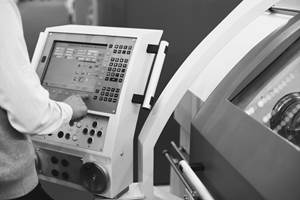Laser System Checks CMMs For Accuracy
A CMM maker describes the laser system it uses to calibrate and service its machines.
Share





Sure, coordinate measuring machines (CMMs) indicate the accuracy of parts, but who checks the accuracy of CMMs? Over the years, Helmel Engineering used several laser calibration systems to calibrate the scales on its CMMs and performing in-field service prior to standardizing on Optodyne, Inc.’s laser calibration system.
“The Optodyne system has sped up our process by a factor of five, allowing the use of smaller measurement increments,” says Art Whistler, vice president of sales and marketing at Helmel Engineering. “This provides a much better correction factor.”
Since 1973, Niagara Falls, New York-based Helmel Engineering has been designing and manufacturing CMMs. The company cites one of its many challenges as being to ensure consistent and accurate measurement along the entire displacement of each axis at resolutions of 0.5 to 0.1 micron. The preferred scales for these inspection machines are made of steel tape with an adhesive back, an arrangement that is said to contribute to accelerating assembly.
The tape comes on a reel and is pulled out to length. A protective backing is peeled off the tape before applying it to the steel frame of the CMM. The adhesive stabilizes after 24 hours, and because the underlying structure is typically steel, the overall system is stable and repeatable.
“The system uses a non-contact, optical reading head to register the gradient coined onto the steel tape, which makes for a convenient, easy-to-install measuring system,” explains Russ Sicard, assembly supervisor at Helmel. “However, it’s not accurate to the precision our customers require. Over the years, we have used laser systems from three manufacturers and standardized on the Optodyne system to calibrate our scales.”
Having received ISO/IEC 17025 accreditation, Optodyne’s equipment and personnel are distinguished as having met international standards. This is much more than conformance to such quality systems as ISO 9000, the company says. ISO/IEC 17025 recognizes laboratory and personnel competence in addition to quality system conformance.
The system requires two optics: a laser head and a retroreflector. Using electro-optics, optical heterodyne techniques and phase-demodulators, the laser calibration system obtains displacement information by measuring the distance from the home position to the retroreflector.
Other laser calibration systems require three optics, including a laser head that must be mounted on a tripod. These systems require a more precise alignment, Helmel says, in turn requiring more time to setup.
“Optodyne is much easier and faster to set up because the alignment process is more tolerant of misalignment without sacrificing accuracy,” Mr. Sicard says.
After aligning the laser system, the calibration process requires the probe structure to be moved using incremental measurements. The operator positions the reading head at the home position and specifies the measurement increment for calibrating the CMM.
The operator moves the reading head a specified distance and the scale readout is noted for later comparison with the laser position. The calibration system automatically senses movement, and after a user-defined interval, data collection is automatically triggered as the table moves and stops. The process continues by stepping through multiple measurements along the full length of each axis.
The deviations between the scale and the positions measured by the laser are calculated, allowing calculation of a compensation table. In some cases, a single linear correction factor is calculated for each axis. In others, a nonlinear incremental correction can be applied along the length of each axis.
It is not unusual to find a specific area of the scale with a higher error factor than other areas, especially as the reading head reaches the extreme length of the axis. This makes the ability to measure in small increments invaluable by exactly pinpointing errors and allowing a non-linear correction factor to be used in a very precise area.
“With our prior two laser calibration systems, we were unable to hook into the output because of proprietary architecture,” Mr. Whistler says. “Optodyne gave us the ability to get inside its software sufficiently to extract and use the readings automatically. Now we can set up an axis to measure the scale deviation by stepping the machine along the axis, extracting the position and applying the compensation internally in an automatic process. In another area, the compactness of the system and all its components and optics make it easy to travel with. So it is clearly the favored system to take on the road when we do field calibration.”
Related Content
The Many Ways of Measuring Thickness
While it may seem to be a straightforward check, there are many approaches to measuring thickness that are determined by the requirements of the part.
Read MoreHelp Operators Understand Sizing Adjustments
Even when CNCs are equipped with automatic post-process gaging systems, there are always a few important adjustments that must be done manually. Don’t take operators understanding these adjustments for granted.
Read MoreChoosing the Correct Gage Type for Groove Inspection
Grooves play a critical functional role for seal rings and retainer rings, so good gaging practices are a must.
Read MoreHow to Choose the Correct Measuring Tool for Any Application
There are many options to choose from when deciding on a dimensional measurement tool. Consider these application-based factors when selecting a measurement solution.
Read MoreRead Next
5 Rules of Thumb for Buying CNC Machine Tools
Use these tips to carefully plan your machine tool purchases and to avoid regretting your decision later.
Read MoreRegistration Now Open for the Precision Machining Technology Show (PMTS) 2025
The precision machining industry’s premier event returns to Cleveland, OH, April 1-3.
Read MoreBuilding Out a Foundation for Student Machinists
Autodesk and Haas have teamed up to produce an introductory course for students that covers the basics of CAD, CAM and CNC while providing them with a portfolio part.
Read More





















.jpg;maxWidth=300;quality=90)











